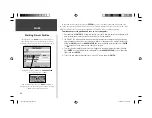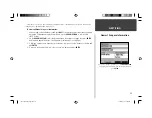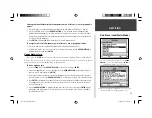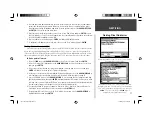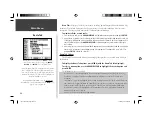
59
Main Menu
GPS Tab
GPS Tab—
provides a visual reference of satellite acquisition, receiver status, and accuracy. The
status information shows what the receiver is doing at any given moment. The sky view and signal
strength bars give an indication of what satellites are visible to the receiver and whether or not they are
being tracked. The signal strength is shown on a bar graph for each satellite, with the satellite number
below. As the receiver locks onto satellites, a signal strength bar will appear for each satellite in view,
with the appropriate satellite number underneath each bar.
The progress of satellite acquisition is shown in three stages:
• No signal strength bars— the receiver is looking for the satellites indicated.
• Light signal strength bars— the receiver has found the satellite(s) and is collecting data.
• Dark signal strength bars— the receiver has collected the necessary data and the satellite(s) are ready
for use.
As soon as the GPSMAP 196 has collected the necessary data from the best satellites in view to
calculate a fi x, the status fi eld will indicate a 2D or 3D status. The unit will then update the position,
date and time.
You can use the sky view to help determine if any satellites are being blocked, and whether you have
a current position fi x (indicated by a ‘2D’,‘2D Differential’,‘3D’, or ‘3D Differential’ in the status fi eld).
The sky view shows a bird’s-eye view of the position of each satellite relative to the receiver’s last known
position. The outer circle represents the horizon (north up), the inner circle 45º above the horizon, and
the center point a position directly overhead. You can also set the sky view to a ‘Track Up’ confi gura-
tion, causing the top of the sky view to align along your current track heading.
WAAS Capability
The GPSMAP 196 is capable of receiving WAAS (Wide Area Augmentation System) satellite signals.
WAAS is an FAA (Federal Aviation Administration) funded project to improve the overall accuracy and
integrity of the GPS signal for aviation use, but land- and sea-based users may also benefi t from this
system. The system is currently still in the development and may not operational at all times. There are
currently two WAAS satellites covering the United States—one over the Atlantic Ocean and one over the
Pacifi c Ocean, in a geostationary orbit over the equator. Effective use of the WAAS satellite signal may
be limited by your geographic location in relation to those satellites or by obstructions.
Sky
View
Signal Strength Bars (“D” indicates
available differential corrections)
WAAS On/Off
Setting
Receiver Status
Differential Status
DOP
and Accuracy
45°
90°
Outer ring -
the horizon
Inner ring- 45°
above the horizon
Center dot - 90°
above the horizon
190-00283-00Backup.indd 59
12/8/2002, 8:09:23 PM
Summary of Contents for GPSMAP GPSMAP 196
Page 1: ...Pilot s Guide Reference GPSMAP 196 196PG Covers indd 1 12 9 2002 4 34 25 PM...
Page 18: ...8 Basic Operation This page intentionally blank 190 00283 00Backup indd 8 12 8 2002 8 08 50 PM...
Page 121: ...190 00283 00Backup indd 111 12 8 2002 8 10 01 PM...
Page 122: ...190 00283 00Backup indd 112 12 8 2002 8 10 01 PM...




